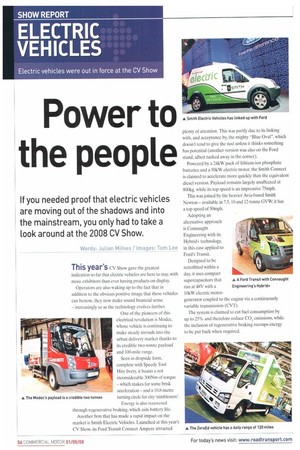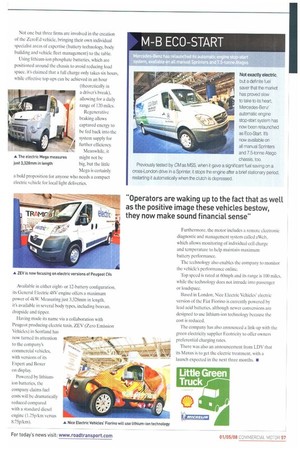Power to the people
Page 56

Page 57

If you've noticed an error in this article please click here to report it so we can fix it.
If you needed proof that electric vehicles are moving out of the shadows and into the mainstream, you only had to take a look around at the 2008 CV Show.
Words: Julian Mimes / images: Tom Lee This year's CV Show gave the greatest indication so far that electric vehicles are here to stay, with more exhibitors than ever having products on display.
Operators are also waking up to the fact that in addition to the obvious positive image that these vehicles can bestow, they now make sound financial sense — increasingly so as the technology evolves further.
One of the pioneers of this electrical revolution is Modec, whose vehicle is continuing to make steady inroads into the urban delivery market thanks to its credible two-tonne payload and 100-mile range.
Seen in dropside form, complete with Speedy Tool Hire livery, it boasts a not inconsiderable 300Nm of torque — which makes for some brisk acceleration — and a 10.8-metre turning circle for city 'nimbleness'.
Energy is also recovered through regenerative braking, which aids battery life.
Another firm that has made a rapid impact on the market is Smith Electric Vehicles. Launched at this year's CV Show, its Ford Transit Connect Ampere attracted plenty of attention. This was partly due to its linking with, and acceptance by, the mighty -Blue Oval", which doesn't tend to give the nod unless it thinks something has potential (another version was also on the Ford stand, albeit tucked away in the corner).
Powered by a 24kW pack of lithium-ion phosphate batteries and a 50kW electric motor, the Smith Connect is claimed to accelerate more quickly than the equivalent diesel version. Payload remains largely unaffected at 800kg, while its top speed is an impressive 75mph.
This was joined by the heavier Avia-based Smith Newton — available in 7.5, 10 and 12-tonne OVW: it has a top speed of 50mph.
Adopting an alternative approach is Connaught Engineering with its Hybrid+ technology, in this case applied to Ford's Transit.
Designed to be retrofitted within a day, it uses compact supercapacitors that run at 48V with a 10kW electric motorgenerator coupled to the engine via a continuously variable transmission (CVT).
The system is claimed to cut fuel consumption by up to 25% and therefore reduce CO2 emissions, while the inclusion of regenerative braking recoups energy to he put back when required. A A Ford Transit with Connaught Engineering's Hybrid+ Not one but three firms are involved in the creation of the ZeroEd vehicle, bringing their own individual specialist areas of expertise (battery technology, body building and vehicle fleet management) to the table.
Using lithium-ion phosphate batteries, which are positioned around the chassis to avoid reducing load space, it's claimed that a full charge only takes six hours, while effective top-ups can be achieved in an hour (theoretically in a driver's break), allowing for a daily range of 120 miles.
Regenerative braking allows captured energy to be fed back into the system supply for further efficiency.
Meanwhile, it might not be big, but the little Mega is certainly a bold proposition for anyone who needs a compact electric vehicle for local light deliveries. A The electric Mega measures just 3,328mm in Length Available in either eightor 12-battery configuration. its General Electric 48V engine offers a maximum power of 4kW. Measuring just 3.328mm in length, it's available in several body types, including boxvan, dropside and tipper.
Powered by lithiumion batteries, the company claims fuel costs will be dramatically reduced compared with a standard diesel engine (1.25p/km versus 8.75p/km). Furthermore, the motor includes a remote electronic diagnostic and management system called zWeb, which allows monitoring of individual cell charge and temperature to help maintain maximum battery performance.
The technology also enables the company to monitor the vehicle's performance online.
Top speed is rated at 60mph and its range is 100 miles, while the technology does not intrude into passenger or loadspace.
Based in London, Nice Electric Vehicles' electric version of the Fiat Fiorino is currently powered by lead acid batteries, although newer conversions are designed to use lithium-ion technology because the cost is reduced.
The company has also announced a link-up with the green electricity supplier E.cotricity to offer owners preferential charging rates.
There was also an announcement from LDV that its Maxus is to get the electric treatment, with a launch expected in the next three months. •




















































































































































































